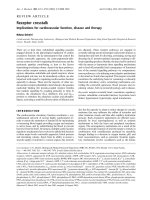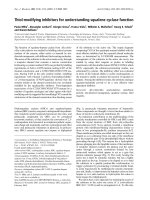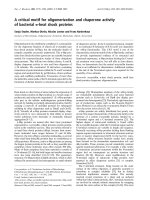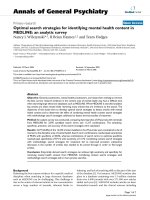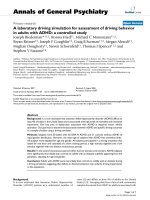Báo cáo y học: "Single-incision thoracoscopic surgery for primary spontaneous pneumothorax" ppt
Bạn đang xem bản rút gọn của tài liệu. Xem và tải ngay bản đầy đủ của tài liệu tại đây (543.56 KB, 4 trang )
RESEARCH ARTICLE Open Access
Single-incision thoracoscopic surgery for primary
spontaneous pneumothorax
Pin-Ru Chen
†
, Chien-Kuang Chen, Yu-Sen Lin, Hsu-Chih Huang, Jian-Shun Tsai, Chih-Yi Chen and Hsin-Yuan Fang
*
Abstract
Objective: Single-incision laparoscopic surgery had been proven effective for appendectomy, cholecystectomy,
and inguinal hernia repair. However, single-incision thoracoscopic surgery (SITS) in primary spontaneous
pneumothorax (PSP) has not been reporte d.
Methods: We prospectively enrolled 30 PSP patients who received thoracoscopic surgery in the division of
Thoracic Surgery of China Medical University Hospital. Ten patients received SITS and 20 patients received
traditional three-port thoracoscopic surgery. The operative time, blood loss, wound size, visual analog scale (VAS)
pain score, and patient satisfaction score were compared.
Results: There was no significant difference in the operative time and blood loss between the two groups.
However, the VAS pain scores were significantly better in the SITS group in first 24 hours after surgery. Patient
satisfaction scores in the SITS group were also significantly better in the first 24 and 48 hours after operation.
Conclusion: Although three-port thoracoscopic surgery for PSP is well established, SITS results in better patient
satisfaction and decreased postoperative pain in the treatment of PSP.
Introduction
Primary sp ontaneous pneumothorax (PSP) is a perplex-
ing disease that usually occurs in young, otherwise
healthy individuals without clinically apparent lung dis-
ease in their late teens or third decade of life [1]. It is
defined by the presence of air in the pleural cavity with
secondary lung collapse, and occurs without a preceding
event or obvious precipitating cause [2]. The incidence
of PSP is approximately 7 to 18 and 1 to 6 cases per
100,000 individuals per year in males and females,
respectively [3]. Surgical resection of th e blebs or bullae
could decrease the recurrent rate.
Thoracoscopic surgical techniques have transformed
may surgical procedures over recent decades. Minimal
access techniques allow extensive operations to be per-
formed with little trauma, leading to faster recovery times
and shorter hospital stays [4]. In abdominal surgery, using
of single-incision lapa roscopic surgery (SILS) for appen-
dectomy, cholecystectomy, and inguinal hernia repaired
have been reported [5-7]. However, single-incision
thoracoscopic surgery (SITS) has not been reported. We
herein describe our technique for performing SITS in
patients with PSP and compare outcomes with three-port
video-assist thoracoscopic surgery (VATS).
Patients and methods
Between March 2009 and July 2009, we prospectively
enrolled 30 consecutive PSP patients who received thor-
acoscopic surgery in the division of Thoracic Surgery of
China Medical University Hospital in central Taiwan.
PSP was defined as spontaneous air accumulation in the
pleural cavity without evidence of clinical lung disease.
The surgical indicatio ns were 1) recurrent episode, 2)
persist air leakage for more than 4 -5 days, and/or 3)
abnormal radiographic findings. The inclusion criteria of
patients were 1) pneumothorax noted by chest radiogra -
phy or chest computerized tomography (CT) scan on
admission to the hospital, 2) patient was between 15
and 40 year s of age, 3) no history of lung diseases, such
as chronic obstructive pulmonary disease, asthma, pul-
monary fibrosis, or pneumoconiosis, and 4) no history
of other systemic d iseases, such as uremia, liver cirrho-
sis, malignancy, or chronic heart and liver diseases. The
exclusion criteria were 1) history of chest trauma, such
* Correspondence:
† Contributed equally
Division of Thoracic Surgery, Department of Surgery, China Medical
University Hospital, China Medical University, Taichung, Taiwan
Chen et al. Journal of Cardiothoracic Surgery 2011, 6:58
/>© 2011 Chen et al; licensee BioMed Central Ltd. This is an Open Access article distribu ted under t he terms of the Creative Commons
Attribution License ( s/by/2.0), which permits unrestricted use, distribution, and reproduction in
any medium, provided the original work is properly cited.
as rib fracture and pulmonary contusion, 2) history of
pneumonia or pulmonary tuberculosis, and 3) history of
pulmonary surgery, including lobectomy, segmentect-
omy, and wedge resection of the lung. PSP was treated
by a wedge resection of the lung using VATS or SITS.
Each patient was fully informed about the difference of
these two methods, such as single incision and three
incisions. The other procedures between these two
methods are all the same. Surgical risks, potential com-
plications were also informed. Written informed con-
sents were obtained. The study was approved by the
Institutional Review Board of the China Medical Univer-
sity. All patients were followed for at least 3 months
postoperatively in the outpatient department.
Surgical technique
SITS
SITS was performed with the p atient under general
anesthesia using one-lung ventilation. The patient was
placed in a lateral position. A skin incision was made
2.5 cm in length through the previous chest thoracost-
omy wound (4th, 5th, or 6th intercostal space) for inser-
tion of a video-thoracoscope through an 11-mm
thoracoport. With the lung deflated, the other two 5-
mm thora coports were inserted next to the 11-mm
thoracoport (Figure 1). The visceral blebs and bullae
were excised u sing a Endo GIA 60 stapler (Autosuture,
United States Surgical Corporation). The subsequent
mechanical pleurodesis was performed with a scouring
pad on the tip of a forceps. After checking for air leaks
and bleeding, one pig-tail drainage tube was inserted
through the incision and connected to an underwater
sealing drain with a suction of 15 cm H
2
O.
VATS
VATS was performed with the patient was under general
anesthesia using one-lung ventilation. The patient was
placed in a lateral position. Three small incisions w ere
used. An initial skin incision was made 1.5 cm in length
through the previous chest tho racostomy wound (5th or
6th intercostal space) f or video-thoracoscope insertion.
With the lung deflated, the other two incisions, 0.5 cm in
length, were made along the anterior-axillary line (4th or
5th intercostal space) and the mid-axillary line (3rd or
4th intercostal space). The v isceral blebs and b ullae were
excised using an Endo GIA 60 stapler (Autosuture). The
subsequent mechanical pleurodesis was performed with a
scouring pad on the tip of forceps. After chec king for air
leaks and bleeding, one pig-tail drainage tube was
inserted through the incision and connected to an under-
water sealing drain with a suction of 15 cm H
2
O.
Visual analog scale (VAS) score
The intensity of postoperative pain was determined
using a VAS score [8]. The VAS scale was an unlabeled
10-cm horizontal line with word anchors at each end,
ranging from 0 = “no pain at all” to 10 = “ pain as bad
as i t could be.” The patients were asked to make a mark
on the line representing the maximum pain intensity
experienced since the last scoring. This mark was con-
verted to distance in centimeters from the “ no pain”
anchor to give a pain score that could range from 0 to
10 cm. Pain scores were taken 24, 48, and 72 h after
surge ry. As the primary outcome variable, we calculated
the mean pain score at each of these 3 times.
Patient satisfaction scale
All the patients were given a form showing 4 grades
(excellent=1,good=2,fair=3,andpoor=4)andthey
were asked to freely evaluate the clinical outcome. Patient
satisfaction scores were taken 24, 48, 72 h, and one
month after surgery. Postoperative patient satisfaction
Figure 1 Surgical approach for primary spontaneous
pneumothorax (PSP) in single incision thoracoscopic surgery
(SITS).
Chen et al. Journal of Cardiothoracic Surgery 2011, 6:58
/>Page 2 of 4
data were colle cted by an independent team that did not
take part in the operative procedures.
Statistical analysis
Categorical variables were expressed as percentages and
continuous variables were expressed as medians ± stan-
dard devia tio n. Continuous variables were compared by
Mann-Whitney U test and categorical variables were
compared by chi-square test or the Fisher’ sexacttest
(when the expected number of an analysis cell was
smaller t han or equal to 5). Statistical analysis was per-
formed by using SPSS software (version 12.0, SPSS Inc.,
Chicago, Illinois, USA). Statistical significance was set at
p < 0.05.
Results
Patient characteristics
Ten patients received SITS and 20 patients received
three-port VATS. The mean age of the PSP patients was
22.97 ± 8.13 years (range, 15 to 40 years), and there
were 28 men and 2 women. Demographic data were
shown in Table 1. Eight patients (27%) were smokers, of
whom the smoking duration and cigarette consumption
were 5.5 ± 2.5 years and 1.2 ± 0.3 packages per day,
respectively. There were no significant differences
between the SITS and VATS groups.
Surgical characteristics of PSP are presented in Table 2.
Surgical indications for PSP were ipsilateral recurrence
(77%), persistent air leakage (10%), and contralateral
recurrence (13%). The mean surgical time was 83 ± 21
min, and mean postoperative hospital stay was 4.6 ± 1.2
days. No d eaths occurred, and no full thoracotomy was
needed during or after surgery. Two pa tients (6.7%) had
air leaks, and were managed conservatively. There were
28 patients who had some bl ebs at the apex, inc luding 2
patients w ho had some bl ebs at the lowe r lobe. Two
patients had no blebs at the apex of the lung. Microscopi-
cally, subpleural blebs were found in 27 (90%) specimens.
There were no significant differences in operative time,
blood loss, postoperative drainage, and postoperative
hospital stay between the two groups. There were no
recurrences during the follow-up period.
VAS score
In the SITS group, the VAS scores at 24, 48, and 72
hour s postoperatively were 4.50 ± 0.70, 4.20 ± 0.78, and
3.30 ± 0.60, respectively, whereas in the VATS g roup,
the VAS scores were 4.95 ± 0.39, 4.25 ± 0.58, and 3.55
± 0.60. The VAS score at 24 h was significantly different
between the two groups (p = 0.032; Table 3).
Patient satisfaction scale
In the SITS group, the patient satisfa ction scale score s
at 24, 48, and 72 hours postoperatively were 1.90 ± 0.74,
2.40 ± 0.52, and 2.30 ± 0.94, respectively, whereas in the
VATS group, the scores were 2.55 ± 0.82, 2.90 ± 0.64,
and 2.45 ± 0.82, respectively. The SITS group had sig-
nificantly better patient satisfaction scale scores than the
VATS group at 24 and 48 hours postoperatively (p =
0.045, p = 0.041, respectively; Table 3).
Table 1 Clinical characteristics of primary spontaneous
pneumothorax (PSP) patients in single incision
thoracoscopic surgery (SITS) and video-assisted
thoracoscopic surgery (VATS)
SITS Group (n = 10) VATS Group (n = 20) P-value
Age (years) 20.50 ± 5.54 24 ± 9.02 0.246
Gender
Male 9 (90%) 19(95%) 0.605
Female 1 (10%) 1(5%)
Weight (kg) 59.47 ± 10.35 57.68 ± 4.78 0.518
Height (cm) 173.77 ± 8.82 172.34 ± 6.21 0.609
Side involved
Right 3 (30%) 6 (30%) 1.000
Left 7 (70%) 14 (70%)
Bilateral 0 (0%) 0 (0%)
Smoking
No 9 (90%) 13 (65%) 0.144
Yes 1 (10%) 7 (35%)
Values are medians ± standard deviation for continuous variables or # cases
(%) for categorical variables. P-values from Mann-Whitney U test (continuous
variables), Chi-square test (categorical variables) or the Fisher’s exact test.
Table 2 Surgical characteristics of primary spontaneous
pneumothorax (PSP) patients in single incision
thoracoscopic surgery (SITS) and video-assisted
thoracoscopic surgery (VATS)
SITS Group
(n = 10
VATS Group
(n = 20)
P-value
Surgical indications
Ipsilateral recurrence 7 (70%) 16 (80%)
Persistent air leaks 2 (20%) 1 (5%)
Contralateral recurrence 1 (10%) 3 (15%) 0.425
Hemopneumothorax 0 (0%) 0 (0%)
Other 0 (0%) 0 (0%)
Presence of bleb
Yes 9 (90%) 19 (95%) 0.605
No 1 (10%) 1 (5%)
Operation time (min) 80.50 ± 20.74 85.50 ± 21.87 0.553
Length of stay (days) 7.80 ± 2.74 7.90 ± 2.22 0.915
Post operation hospital stay
(days)
4.40 ± 0.96 4.85 ± 1.46 0.387
Blood loss (mL) minimal minimal
Post operative drainage
(days)
3.00 ± 0.94 3.55 ± 1.50 0.301
Values are medians ± standard deviation for continuous variables or # cases
(%) for categorical variables. P-values from Mann-Whitney U test (continuous
variables), Chi-square test (categorical variables) or the Fisher’s exact test.
Chen et al. Journal of Cardiothoracic Surgery 2011, 6:58
/>Page 3 of 4
Discussion
The major diffi cul ty with SITS stems from the need for
the surgeon to adapt to the new method of instrumenta-
tion. The SITS technique is not a naturally ergonomic
technique, because the traditional thoracoscopic princi-
ples of triangulation are lost. Because both the operating
instruments and thoracoscope are introduced through
the same incision, and on the same axis, the operator
and assistant often impede the movements of each
other. This is not helped by current instrumentation,
which has not been designed with the single-incision
approach in mind. Instruments often interf ere with each
other, not only within the pleural space, but also extra-
pleurally, where attachment ssuchasthecameralight
lead often impede movement. This makes clear and
accurate communication between surgeon and assistant
essential, especially with regard to intraoperative compli-
cations such as bleeding.
In our experience, mild adhesions could be managed
with diathermy and reticu lated instruments, and good
hemostasis is possible with the SITS approach. Bleeding
from the cupola or apex of the lung can be treated with
diathermy, and bleeding from aberrant vessels between
cupola and apex of lung can be managed with applica-
tion of the EndoCLIP (Covidien, USA) device. If hemos-
tasis is difficult to achieve with the SITS approach, we
advocate the insertion of additional thoracoscopic ports
to improve surgical dexterity, with conversion to a mini-
thoracotomy procedure if necessary.
In the future, we hope these difficulties will be alle-
viated by the development of new, in line instruments,
which will avoid interference. Also, increasing the length
of the camera shaft would allow the assistant to stand
comfortably with his or her hands away from those of
the operating surgeon.
In our report, we have shown SITS for the manage-
ment of PSP to be a safe and effective technique. To
date, the apparent advantages of the SITS technique are
primarily related to patient satisfaction. Although three-
port thoracoscopic surgery for PSP has been well estab-
lished, SITS seems to be better choice. Further work in
the form of rando mized controlled trials are needed to
evaluate the potential benefits of this new technique
before its use can be widely recommended.
Conclusion
Although three-port thoracosco pic surgery for PSP is
well established, SITS results in better patient satisfac-
tion and decreased postoperative pain in the treatment
of PSP.
Authors’ contributions
PRC wrote the manuscript and revised it. CKC and YSL collected and
analyzed the data, HCH carried out the surgical intervention of patients. JST
cared the patients in the study. CYC carried out coordination between
authors. HYF established the study structures.
Competing interests
PRC, JGC, YSL, HCH, JST, CYC, and HYF have no conflicts of interest or
financial ties to disclose. The authors alone are responsible for the content
and writing of the paper.
Received: 8 February 2011 Accepted: 21 April 2011
Published: 21 April 2011
References
1. Noppen M: Management of primary spontaneous pneumothorax. Curr
Opin Pulm Med 2003, 9:272-275.
2. Weissberg D, Refaely Y: Pneumothorax: experience with 1,199 patients.
Chest 2000, 117:1279-1285.
3. Morimoto T, Shimbo T, Noguchi Y, et al: Effects of timing of thoracoscopic
surgery for primary spontaneous pneumothorax on prognosis and costs.
Am J Surg 2004, 187:767-774.
4. Keus F, de Jong JA, Gooszen HG, van Laarhoven CJ: Laparoscopic versus
open cholecystectomy for patients with symptomatic cholecystolithiasis.
Cochrane Database Syst Rev 2006, CD006231.
5. Chow A, Purkayastha S, Aziz O, Paraskeva P: Single-incision laparoscopic
surgery for cholecystectomy: an evolving technique. Surg Endosc 2009,
24(3):709-14.
6. Chow A, Purkayastha S, Paraskeva P: Appendicectomy and
Cholecystectomy Using Single-Incision Laparoscopic Surgery (SILS): The
First UK Experience. Surg Innov 2009, 16(3):211-7.
7. Filipovic-Cugura J, Kirac I, Kulis T, Jankovic J, Bekavac-Beslin M: Single-
incision laparoscopic surgery (SILS) for totally extraperitoneal (TEP)
inguinal hernia repair: first case. Surg Endosc 2009, 23:920-921.
8. Duncan JA, Bond JS, Mason T, et al: Visual analogue scale scoring and
ranking: a suitable and sensitive method for assessing scar quality? Plast
Reconstr Surg 2006, 118:909-918.
doi:10.1186/1749-8090-6-58
Cite this article as: Chen et al.: Single-incision thoracoscopic surgery for
primary spontaneous pneumothorax. Journal of Cardiothoracic Surgery
2011 6:58.
Table 3 Visual analog scale (VAS) score and patient
satisfactory scale of primary spontaneous pneumothorax
(PSP) patients in single incision thoracoscopic surgery
(SITS) and video-assisted thoracoscopic surgery (VATS)
SITS Group
(n = 10
VATS Group
(n = 20)
P-value
Visual analog scale (VAS) score
Preoperation
24 hours 4.50 ± 0.70 4.95 ± 0.39 0.032*
48 hours 4.20 ± 0.78 4.25 ± 0.58 0.088
72 hours 3.30 ± 0.48 3.55 ± 0.60 0.265
Patient satisfactory scale
24 hours 1.90 ± 0.74 2.55 ± 0.82 0.045*
48 hours 2.40 ± 0.52 2.90 ± 0.64 0.041*
72 hours 2.30 ± 0.94 2.45 ± 0.82 0.659
Values are medians ± standard deviation for variables. P-values from Mann-
Whitney U test.
Chen et al. Journal of Cardiothoracic Surgery 2011, 6:58
/>Page 4 of 4

